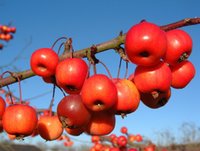 Crab Apple (‘Malus’) described in ‘Trees For Life’ by Frank P. Matthews as “the most diverse of garden trees; flower, foliage, fruit and autumn colours.”
Crab Apple (‘Malus’) described in ‘Trees For Life’ by Frank P. Matthews as “the most diverse of garden trees; flower, foliage, fruit and autumn colours.”
Mill Garden Restoration: It’s thought that Crab Apples have been grown here for over a thousand years and have a close association to the name ‘Crabble’. Even in Roman times Crab Apples were stored as ripened and dried fruit, also crushed to produced cider or the liquid sold as a culinary item called “verjuice”. It’s also thought that early mills here pressed apples into cider as well as ground grain into flour.
Brogdale Horticultural Trust in Faversham ‘Home of the National Fruit Collections’ with over 2,300 varieties of apples are helping us create The Collection. We have chosen a selection of 16 varieties of Crab Apple trees, each with their different attributes of blossom, leaf, fruit and shape of tree. These are to be planted in the gardens of Crabble Corn Mill.
Our trees are to be grafted onto dwarf stocks whereby they will each reach a maximum height of 3 metres (10 foot) after 10 years growth. Grafting will take place shortly and we will know by March/April how well the grafts have taken. Brogdale will nurture our trees through the spring and summer next year for us to plant in the Mill gardens in autumn 2007.
Sponsorship for each tree is £37 to cover these costs. Each tree will have a small plaque and each sponsor will receive a Certificate with photo of their tree type in recognition.
:: Celebrate a birth ::
:: Mark a marriage ::
:: Commemorate a loved one ::
Species, Harry Baker: dark pink blossom, ruby fruit 'til mid-Oct. Sponsor Patricia & Harry Reid, dedication "The Reid Family".
Crittenden: pale pink flower, scarlet fruit into winter. Sponsor Claire & Robin Sedgwick, dedication "name".
Golden Gem: pure white scented flower, yellow apple. Sponsor The Walters Family, dedication "name".
Sun Rival: weeping, pink white blossom, bright red fruit. Sponsor Mark, dedication "name".
Trilobata: white flower/maple leaf, late June onwards. Sponsor M. Phillips, dedication "name".
Prairie Fire: purple red flower. Sponsor The Old Rectory Residential Home, Dedication "The Residents of The Old Rectory, Ash
White Star: white blossom, golden fruit into December. Sponsor Ant Reid, dedication "Honey, Huskin, Chi, Striker".
Butterball: white blossom, butter-coloured apple. Sponsor Butterworth Family, dedication "Pee-Tree."
Pink Glow: white flower, bright pink apple makes good jelly. Sponsor Glyn & Gigi Thomas, dedication "name".
Gorgeous: pure white flower, glossy red apple until November. Sponsor Mrs E Fincham, dedication "Buster".
Laura: pink/white blossom, maroon apple makes good jelly. Sponsor Violet & Fred Gore, dedication "name".
Rudolf: single pink flower, summer. Sponsor The Goldup Family, dedication "Ray".
Toringoides: cream white blossom, red/yellow pear-shaped apple. Sponsor N Anthony, dedication "for Jo".
Liset: crimson flower, small blood-red fruit. Sponsor Mr & Mrs A. Womar, dedication "in memory of Sheila Howes".
Transitoria: yellow blossom, small and abundant in apples. Sponsor Colin & Maureen Hall, dedication "name".
Admiration: waxy white flower, red-bronze apple to December. Sponsor Miss B Harden & Mrs V Tinley, dedication "A Christmas Tree To Last A Lifetime".
Contact the Mill,
sponsor your tree.







